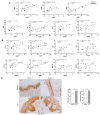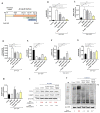NAMPT and PARylation Are Involved in the Pathogenesis of Atopic Dermatitis
- PMID: 37175698
- PMCID: PMC10178103
- DOI: 10.3390/ijms24097992
NAMPT and PARylation Are Involved in the Pathogenesis of Atopic Dermatitis
Abstract
Atopic dermatitis (AD) is a chronic inflammatory skin disease of very high prevalence, especially in childhood, with no specific treatment or cure. As its pathogenesis is complex, multifactorial and not fully understood, further research is needed to increase knowledge and develop new targeted therapies. We have recently demonstrated the critical role of NAD+ and poly (ADP-ribose) (PAR) metabolism in oxidative stress and skin inflammation. Specifically, we found that hyperactivation of PARP1 in response to DNA damage induced by reactive oxygen species, and fueled by NAMPT-derived NAD+, mediated inflammation through parthanatos cell death in zebrafish and human organotypic 3D skin models of psoriasis. Furthermore, the aberrant induction of NAMPT and PARP activity was observed in the lesional skin of psoriasis patients, supporting the role of these signaling pathways in psoriasis and pointing to NAMPT and PARP1 as potential novel therapeutic targets in treating skin inflammatory disorders. In the present work, we report, for the first time, altered NAD+ and PAR metabolism in the skin of AD patients and a strong correlation between NAMPT and PARP1 expression and the lesional status of AD. Furthermore, using a human 3D organotypic skin model of AD, we demonstrate that the pharmacological inhibition of NAMPT and PARP reduces pathology-associated biomarkers. These results help to understand the complexity of AD and reveal new potential treatments for AD patients.
Keywords: NAD+; NAMPT; PARP; atopic dermatitis; skin inflammation.
Conflict of interest statement
The authors declare no competing interest.
Figures






References
-
- Martínez-Morcillo F.J., Cantón-Sandoval J., Martínez-Navarro F.J., Cabas I., Martínez-Vicente I., Armistead J., Hatzold J., López-Muñoz A., Martínez-Menchón T., Corbalán-Vélez R., et al. NAMPT-Derived NAD+ Fuels PARP1 to Promote Skin Inflammation through Parthanatos Cell Death. PLoS Biol. 2021;19:e3001455. doi: 10.1371/journal.pbio.3001455. - DOI - PMC - PubMed
MeSH terms
Substances
LinkOut - more resources
Full Text Sources
Medical
Research Materials
Miscellaneous

